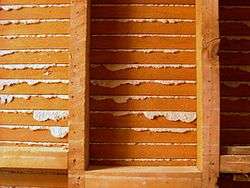Lath and plaster

Lath and plaster is a building process used to finish mainly interior walls and ceilings in Canada and the United States until the late 1950s. After the 1950s, drywall began to replace the lath and plaster process in the United States.
In the United Kingdom and its colonies, lath and plaster was often used for interior partition walls and the construction of ceilings, before the introduction of plasterboard in the 1930s.[1] In the U.K., riven or split hardwood laths were often used of random lengths and sizes. Splitting the timber, as opposed to sawing in straight lines, followed the grain of the timber which greatly improved strength and durability. Also, reed mat was used as a lath. The technique derives historically from the earlier, more primitive, wattle and daub.[2]
Description

The wall or ceiling finishing process begins with wood laths. These are narrow strips of wood, or split boards, nailed horizontally across the wall studs or ceiling joists. Each wall frame is covered in lath, tacked at the studs. The lath is typically about one inch (2.5 cm) wide by four feet (1.22 meters) long by 1⁄4 inch (6.4 mm) thick. Each horizontal course of lath is spaced about 3⁄8 inch (9.5 mm) away from its neighboring courses.
Temporary lath guides are then placed vertically to the wall, usually at the studs. Plaster is then applied, typically using a wooden board as the application tool. The applier drags the board upward over the wall, forcing the plaster into the gaps between the lath and leaving a layer on the front the depth of the temporary guides, typically about 1⁄4 inch (6.4 mm). A helper feeds new plaster onto the board, as the plaster is applied in quantity. When the wall is fully covered, the vertical lath "guides" are removed, and their "slots" are filled in, leaving a fairly uniform undercoat.
In three coat plastering it is standard to apply a second layer in the same fashion, leaving about a half inch of rough, sandy plaster (called a brown coat or browning (UK)). A smooth, white finish coat goes on last. After the plaster is completely dry, the walls are ready to be painted. In this article's photo ("lath seen from the back...") the curls of plaster are called keys and are necessary to keep the plaster on the lath. Traditional lime based mortar/plaster often incorporates horsehair which reinforces the plasterwork, thereby helping to prevent the keys from breaking away.
Eventually the wood laths became less common, and were replaced with rock lath (also known as "button board"), which is a type of gypsum wall board with holes spaced regularly across it, usually in sheets sized 2 feet (24 in) by 4 feet (48 in) (60 cm by 120 cm). The purpose of the four-foot length is so that the sheet of lath reaches exactly across three wall studs, which are spaced 16 inches (410 mm) apart on center (United States building code standard measurements). The holes serve the same purpose as the spaces between the wood lath strips, allowing plaster to ooze through the board when the plaster is applied, making the keys to hold the plaster to the wall board.
In addition to rock lath, there were various types of metal lath which is categorized according to weight, type of ribbing, and whether the lath is galvanized or not. Metal lathing was spaced across a 13.5 inch center, attached by tie wires using lathers' nippers. Sometimes, the mesh was dimpled to be self-furring.
Lath and plaster has been mostly replaced with solid drywall or plasterboard (also a type of gypsum wall board, although a bit thicker), since it is faster and less expensive to install.
Advantages
An advantage of using lath is for ornamental or unusual shapes. For instance, building a rounded wall would be difficult if drywall were used exclusively, as drywall is not flexible enough to allow tight radii. Wire mesh often used for exterior Stucco is also found in combination or replacement of lath and plaster which serves similar purpose.
Traditional lath and plaster has superior sound-proofing qualities when used with lime plaster (which is denser than modern gypsum board).[1]
In many historic buildings lath and plaster ceilings have a major role for the prevention of fire spread. "They are critical to the protection of horizontal elements such as timber joisted floors, including the flooring on top, which in terms of fire performance is often in a poor condition due to the presence of gaps."[3]
See also
References
- 1 2 Jeff Howell, On the level: is the old plaster best?, The Telegraph (London), May 10, 2006. Retrieved 2012-03-30.
- ↑ Oliver, Paul (2006). Built to meet needs : cultural issues in vernacular architecture (First ed). Architectural, Amsterdam ; London
- ↑ "Fire Resistance of Historic Fabric" by Peter Jackman - http://www.buildingconservation.com/articles/fireresist/fire_resistance.htm
External links
| Look up lath or plaster in Wiktionary, the free dictionary. |
- Plaster Base Installation, Building Construction & Finishing
- Preservation Brief No. 21 by the National Park Service. Contains detailed descriptions of Lath & Plaster construction and advisories on repairing and restoring these walls (especially in historic buildings).